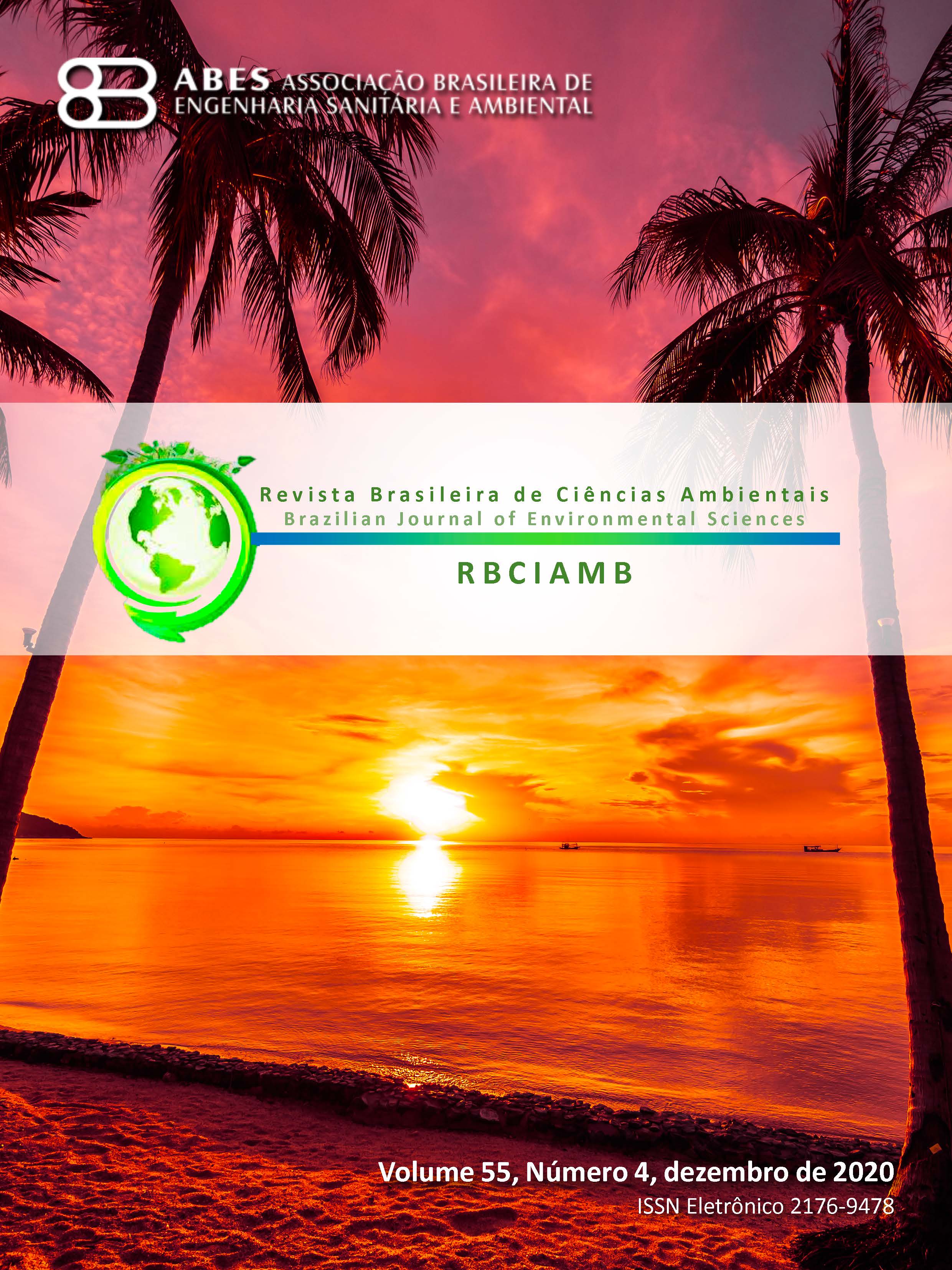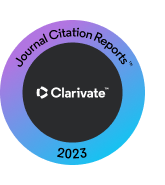INTEGRATION OF ENVIRONMENTAL MODELING TOOLS, LANDSCAPE FRAGMENTATION AND STATISTICAL TREATMENTS IN THE EVALUATION OF WATER QUALITY
DOI:
https://doi.org/10.5327/Z2176-947820200651Keywords:
cellular automata; management of water resources; scenario prediction.Abstract
Environmental modeling is a computational process of wide applications, including projection of scenarios through cellular automata, in which cells interact by means of predefined conditions allowing the prediction of future scenarios. In this way, it is possible to evaluate, for example, the evolution of human activities in hydrographic basins using cartographic bases and satellite images. This projection is important for water quality as water resources are severely affected by human activities. Thus, the present study aims to simulate scenarios for 15 years in an area located in the hydrographic basin of Ribeirão Vermelho, in the municipalities of Sabará, Santa Luzia, and Taquaraçu de Minas, located in the Metropolitan Region of Belo Horizonte, Minas Gerais, integrated with the fragmentation of the landscape and water quality data. The different information collected was associated to infer about the current state of the waters and to predict, according to future scenarios, decision-making to improve water quality. Initially, the use and occupation of land in the three-year hydrographic basin (1996, 2006, and 2016) was mapped into classes. The classes were divided into natural and man-made areas and, associated with the drainage files, road network and altitude, being the inputs for the model of landscape projections. The projection indicated that between 1996 and 2016 the remnants of tree vegetation in the hydrographic basin decreased from 70 to 55% and the results of water analysis showed that the stream does not meet the framing values according to DN 20/1997. The scenarios projected by the landscape model demonstrated the advance of anthropized areas over natural ones, which in 2032 may stand out, covering about 60% of the hydrographic basin. In addition, these projections associated with physical-chemical parameters indicate a tendency to decrease water quality, making decisions necessary to improve this projection, aiming to meet the class I classification of the watercourse.
Downloads
References
BRASIL. Lei nº 12.651, de 25 de maio de 2012. Dispõe sobre a proteção da vegetação nativa. Brasil, 2012. Disponível em: <http://www.planalto.gov.br/ccivil_03/_ato2011-2014/2012/lei/l12651.htm>. Acesso em: 18 dez. 2019.
BRASIL. Ministério do Meio Ambiente. Modelagem de sistemas ambientais: dinâmica EGO. Disponível em: <https://www.mma.gov.br/estruturas/sbf_chm_rbbio/_arquivos/02_flavio_oliveira___dinamica_ego.pdf>. Acesso em: 18 dez. 2019.
CONSELHO ESTADUAL DE POLÍTICA AMBIENTAL (COPAM). Deliberação normativa nº 20, de 24 de junho de 1997. Dispõe sobre o enquadramento das águas da bacia do rio das Velhas. COPAM, 1997. Disponível em: <http://pnqa.ana.gov.br/Publicacao/Minas%20Gerais%20-%20Rio%20das%20Velhas%20-%20Bacia%20do%20S%C3%A3o%20Franscisco.pdf>. Acesso em: 18 jun. 2020.
INSTITUTO BRASILEIRO DE GEOGRAFIA E ESTATÍSTICA (IBGE). Mapeamento Sistemático do Brasil. Brasil: IBGE, 2012. Disponível em: <http://portaldemapas.ibge.gov.br/portal.php#homepage>. Acesso em: 2 ago. 2017.
LANDSAT. Imagens de satélite. Catálogo de imagens INPE. 1996. Disponível em <http://www.dgi.inpe.br/CDSR/>. Acesso em: 2 ago. 2017.
LANDSAT. Imagens de satélite. Catálogo de imagens INPE. 2006. Disponível em <http://www.dgi.inpe.br/CDSR/>. Acesso em: 2 ago. 2017.
LANDSAT. Imagens de satélite. Catálogo de imagens INPE. 2016. Disponível em <http://www.dgi.inpe.br/CDSR/>. Acesso em: 2 ago. 2017.
MATEUS, M.; GONÇALVES, J.; LOPES JUNIOR, G.; OKURA, M. Análise de incerteza e modelagem de qualidade da água do rio Uberaba, Minas Gerais. Revista Brasileira de Ciências Ambientais, n. 37, p. 1-15, 2015. Disponível em: <https://doi.org/10.5327/Z2176-947820159914>. Acesso em: 18 jun. 2020.
MELOTTI, G. Aplicação de autômatos celulares em sistemas complexos: um estudo de caso em espalhamento de epidemias. Dissertação (Mestrado) – Universidade Federal de Minas Gerais, Belo Horizonte, 2009.
OHNUMA JR., A.; MENDIONDO, E. Análise de cenários com proposição de medidas de recuperação ambiental para a micro-bacia do Tijuco Preto, São Carlos-SP. Revista Brasileira de Ciências Ambientais, n. 32, p. 42-51, 30 jun. 2014. Disponível em: <http://rbciamb.com.br/index.php/Publicacoes_RBCIAMB/article/view/247/202>. Acesso em: 19 jun. 2020.
OPEN STREET MAP. Mapas do Mundo. Disponível em: <https://www.openstreetmap.org/>. Acesso em: 2 ago. 2017.
PAIVA, A.C.E.; NASCIMENTO, N.; RODRIGUEZ, D.A.; TOMASELLA, J.; CARRIELLO, F.; REZENDE, F.S. Urban expansion and its impact on water security: The case of the Paraíba do Sul River Basin, São Paulo, Brazil. Science of the Total Environment, v. 720, 137509, 2020. Disponível em: <https://www.sciencedirect.com/science/article/pii/S0048969720310202>. Acesso em: 20 jun. 2020. https://doi.org/10.1016/j.scitotenv.2020.137509
SOARES-FILHO, B.S.; RODRIGUES, H.O.; COSTA, W.L. Modelagem de Dinâmica Ambiental com Dinâmica EGO. Belo Horizonte: Universidade Federal de Minas Gerais, 2009.
YANG, J.; GONG, J.; TANG, W.; LIU, C. Patch-based cellular automata model of urban growth simulation: Integrating feedback between quantitative composition and spatial configuration. Computers, Environment and Urban Systems, v. 79, 101402, 2020. Disponível em: <https://www.sciencedirect.com/science/article/pii/S0198971519300511?via%3Dihub>. Acesso em: 20 jun. 2020.
Downloads
Published
How to Cite
Issue
Section
License
Copyright (c) 2020 Revista Brasileira de Ciências Ambientais

This work is licensed under a Creative Commons Attribution 4.0 International License.

























